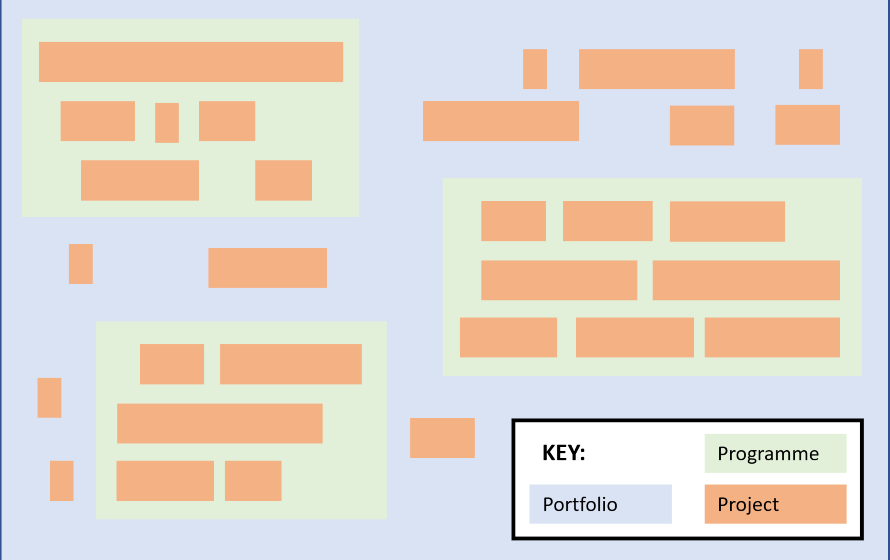Portfolios and portfolio management
Organisations are increasingly turning to project portfolio management to enable them to realise better returns on project investments. Portfolio management helps ensure that an organisation’s portfolios of projects and programmes help it meet its strategic goals.

Understanding portfolios
The concepts of portfolios, programmes, and projects are commonly mixed up and frequently lead to confusion. This article aims to untangle these notions, providing insights into their unique characteristics, goals, and management strategies.
By attaining a clearer understanding of these terms, professionals and businesses can make more knowledgeable strategic choices, thus elevating the overall effectiveness of their strategic endeavours. Additionally, it can assist organizations in determining whether embracing specific project management methodologies such as PRINCE2 for projects, MSP for programmes, and MoP for portfolios can facilitate the efficient management of their projects, programmes, and portfolios.
Definition of portfolios
Portfolios serve as the apex of organizational investments. A portfolio encompasses all the projects, programmes, and ongoing operational activities that are grouped together to fulfil strategic business goals.
In contrast to projects and programmes, which centre on execution and delivery, portfolios concentrate on the broader perspective. They involve making determinations regarding which initiatives to pursue, guided by considerations such as strategic alignment, risk assessment, return on investment, and other pertinent factors.
Differences between projects, programmes, and portfolios
This table shows the differences between projects, programmes, and portfolios.
| Projects | Programmes | Portfolios | |
| Purpose and objectives | Deliver specific, outputs within a set time and cost. | Manage a group of related projects to achieve a broader set of strategic outcomes. | Optimize the allocation of resources across multiple projects and programmes to achieve the organization’s strategic objectives. |
| Scope and timeframe | Have an agreed scope and timeframe. They start, deliver the scope, and then close. | Have a broader scope, involving multiple related projects. Their timeframe continues until all the desired outcomes are achieved. | Are ongoing, continuously adding and removing projects and programmes based on strategic alignment, resource availability, and performance. |
| Management approach | Emphasizes delivering specific outputs, adhering to a project plan, whilst managing issues and risks. | Coordinates multiple related projects to achieve a common outcome. Focuses on managing interdependencies between projects and realizing benefits. | Focuses more on strategic decision-making by prioritizing initiatives, allocating resources, and balancing risk and reward across the portfolio. |
Portfolio management
Portfolio management is a fluid decision-making process through which an organization continually assesses and revises its roster of ongoing projects and programmes to align with its strategic goals. This process encompasses the identification, prioritization, authorization, and oversight of projects, programmes, and portfolios.
Key aspects of portfolio management encompass strategic alignment, risk mitigation, resource allocation, and the achievement of anticipated benefits.
Several established portfolio management frameworks, built upon industry best practices, are available for organizations to implement. These frameworks aid organizations in enhancing the management of their portfolios of change initiatives.
Critical bridge between strategy and execution
At a strategic level, portfolios serve as a critical bridge between the formulation of strategy and its execution. They assume a pivotal role in organizational governance by providing a comprehensive overview of all ongoing initiatives. This panoramic perspective empowers leaders to make well-informed decisions regarding resource allocation, optimizing value, risk management, and the attainment of strategic objectives.
Strategic alignment of portfolios
A primary objective of portfolio management is to guarantee that an organization’s projects and programmes remain aligned with its strategic goals. This entails regularly evaluating and adapting the portfolio to mirror shifts in the business landscape, strategic trajectory, and resource availability.
Through the harmonization of all initiatives with the overarching business strategy, portfolio management assists organizations in realizing their strategic vision, effectively managing risks, and maximizing returns on investment.
Projects, programmes, and portfolios

Projects and programmes are the foundations of portfolios
Programmes and projects serve as the foundational elements of portfolios. Each programme or project integrated within a portfolio should be in sync with the organization’s strategic objectives. The cumulative performance of these programmes and projects is the yardstick for evaluating the portfolio’s success. Through the delivery of their distinct outputs (projects) and outcomes (programmes), they actively contribute to the realization of the strategic goals encapsulated within the portfolio.
Striking a balance between projects, programmes, and portfolios
Striking a balance and aligning projects, programmes, and portfolios is a strategic endeavour that guarantees the collective contribution of all initiatives toward the overarching business objectives. This entails the routinely assessing the portfolio and making requisite adaptations in response to shifts in business strategy, project performance, or the availability of resources.
Effective alignment and balance serve as key enablers for the optimal utilization of resources, the comprehensive management of risks at every level, and the organization’s ability to flexibly adapt to evolving circumstances while remaining steadfast on the path to achieving its strategic objectives.
Effective management of portfolios
Essential skills for portfolio managers
Effective management of portfolios requires a range of skills including:
- Strategic thinking to align initiatives with business strategy.
- Leadership to inspire and guide.
- Risk management to anticipate and mitigate risks across the portfolio.
- Communication skills to deliver clear, timely information to stakeholders at the highest levels in the organization.
- Soft skills such as negotiation, prioritization, the ability to see the bigger picture, as well as many other skills.
Proficient portfolio management necessitates a diverse set of skills, including the ones below.
Strategic thinking
The capability to align initiatives with the organization’s overarching business strategy.
Leadership
The capacity to inspire and provide guidance, driving initiatives toward success.
Communication skills
The ability to convey clear and timely information to stakeholders at the highest echelons of the organization.
Soft skills
This includes competencies like negotiation, prioritization, the aptitude to perceive the broader perspective, and a myriad of other skills that contribute to effective portfolio management.
Risk management
The skill to anticipate and proactively mitigate risks spanning the entire portfolio.
Tools and techniques for portfolio management
An array of tools and techniques are instrumental in portfolio management, including the ones below.
Risk management tools
These help to identify and mitigate risks within the portfolio, ensuring proactive risk management.
Communication platforms
Efficient communication is facilitated through dedicated platforms, fostering seamless information exchange among stakeholders.
Business analytical tools and models
Tools like SWOT analysis, PESTLE analysis, and cost-benefit analysis play a pivotal role in supporting strategic decision-making within portfolio management, providing valuable insights and data-driven guidance.
Advantages and challenges in portfolio management
Effective portfolio management yields numerous advantages, such as:
Improved strategic alignment
Ensuring that all initiatives are in harmony with the organization’s strategic direction.
Optimized resource utilization
Maximizing the efficient allocation of resources across various projects and programmes.
Better risk management
Proactively identifying, assessing, and mitigating risks at the portfolio level.
Enhanced stakeholder satisfaction
Meeting the expectations and needs of stakeholders, thus bolstering their satisfaction.
However, it also poses challenges, including:
Managing interdependencies
Handling the intricate relationships and dependencies among different projects and programmes.
Dealing with uncertainties
Navigating through uncertain situations and adapting to unforeseen circumstances.
Balancing competing demands
Prioritizing and managing competing demands and constraints within the portfolio.
Ensuring effective communication
Facilitating clear and efficient communication across diverse levels and entities within the organization to maintain alignment and understanding.
Governance in portfolio management
Robust governance is indispensable for the effective management of portfolios. This entails several key components including the ones below.
Defining clear roles and responsibilities
Establishing unambiguous roles and responsibilities for portfolio management team members and stakeholders.
Establishing decision-making frameworks
Creating structured decision-making processes to guide portfolio-related choices.
Implementing performance monitoring mechanisms
Setting up systems to monitor and evaluate the performance of projects, programmes, and the overall portfolio.
Ensuring compliance with standards and regulations
Adhering to relevant industry standards, regulations, and best practices.
Strong governance serves as a pillar of support for transparency, accountability, and consistency. These attributes are instrumental in achieving strategic objectives and bolstering stakeholder confidence in the portfolio management process.
Integrating with strategy
Integrating projects, programmes, and portfolios into business strategy is a reciprocal process. On one hand, strategic objectives serve as guiding principles, influencing the choice and ranking of projects and programmes within the portfolio.
Conversely, the outputs from projects, outcomes from programmes, and the achievement of benefits offer valuable insights that can shape and enhance the business strategy.
This interconnectedness ensures that strategic objectives are translated into tangible initiatives, and the journey toward these objectives is systematically monitored and assessed for progress.
Role of leadership
Leadership assumes a pivotal role in cultivating synergy among projects, programmes, and portfolios. Leaders are instrumental in several aspects including the following.
Setting direction
They establish the course and provide a clear sense of purpose.
Communicating vision
Leaders convey the overarching vision, ensuring alignment and understanding among all stakeholders.
Fostering collaboration
They create an environment that encourages cooperation, teamwork, and knowledge-sharing.
Ensuring alignment
Leaders guarantee that the goals of individual projects harmonize with programme objectives, and that all programme objectives contribute to the strategic goals embodied in the portfolio.
Through effective leadership, organizations can enhance coordination, manage complex interdependencies, and drive collective success across their projects, programmes, and portfolios.
Realising value
Achieving success in portfolios hinges on the effective realization of anticipated benefits. This process entails ongoing monitoring and assessment of performance against predetermined criteria or key performance indicators (KPIs).
These evaluations encompass both tangible metrics, such as cost savings or revenue growth, and intangible factors, like heightened customer satisfaction or an enhanced brand reputation. A thorough assessment of success and value realization empowers organizations to demonstrate the return on investment (ROI) of their initiatives, glean valuable insights from their experiences, and enhance their performance in future endeavours.
Project management office (PMO)
In recent years, progressively mature organizations have made significant investments in establishing Project Management Offices (PMOs) not only at the project level but also at the programme and portfolio levels.
PMOs offer a host of advantages to organizations, including the following:
Standardization and consistency
Ensuring uniformity and consistency in project and programme management practices.
Improved governance
Enhancing oversight, control, and compliance with regulations and standards.
Resource optimization
Efficiently allocating and managing resources across various initiatives.
Knowledge management
Facilitating the capture, sharing, and application of knowledge and best practices.
Strategic alignment
Ensuring that projects and programmes align with the overarching strategic goals of the organization.
Many of these organizations have adopted the best practice framework for Portfolio, Programme, and Project Offices (P3O®) to support the successful delivery of their portfolio of change initiatives and projects, leveraging standardized and effective PMO practices.
Digital transformation
Technology in management
The advent of digital transformation has significantly improved the coordination and collaboration in the management of portfolios, programmes, and projects. The utilization of project management software, collaborative platforms, and cloud-based tools empowers real-time progress tracking, efficient resource allocation, and fosters enhanced communication among team members.
These innovative tools streamline the management of interdependencies, enhance decision-making processes, and enable seamless teamwork, irrespective of team members’ geographical locations.
Data-driven decision-making
Digital transformation has ushered in increased data accessibility, making it easier to embrace data-driven decision-making in portfolio, programme, and project management. Cutting-edge analytics and visualization tools empower managers to evaluate performance, detect trends, forecast potential risks, and arrive at well-informed decisions.
Furthermore, machine learning and artificial intelligence algorithms offer insights and recommendations that elevate strategic decision-making within portfolios and enhance operational decision-making within projects and programmes.
Automation
Digital transformation has introduced automation to a multitude of management processes, resulting in heightened efficiency and precision. Activities like updating project statuses, monitoring alterations, scheduling meetings, or allocating resources can now be automated, liberating managers to concentrate on strategic matters.
Moreover, digital platforms enable the efficient documentation and dissemination of knowledge, fostering a culture of learning and continuous improvement in portfolio, programme, and project management.
Case study
Let’s now look at a case study of a fictional company which is utilizing portfolio management.
Company overview
ABC Enterprises is a leading global technology company operating in multiple markets. In recent years, the company has experienced rapid growth, expanding its product offerings and geographic reach. However, this growth has also brought about an increased complexity in managing a diverse portfolio of change initiatives.
The challenge
As ABC Enterprises continued to grow, the management team faced the challenge of efficiently coordinating and aligning various projects and programmes with the company’s overarching strategic objectives. There was a lack of visibility into resource allocation, and project interdependencies often went unnoticed until issues arose. This resulted in delays, resource bottlenecks, and a potential misalignment with the company’s strategic goals.
Implementing portfolio management
Recognizing the need for a structured approach, ABC Enterprises implemented a comprehensive portfolio management framework. They established a Portfolio Management Office (PMO) responsible for overseeing and optimizing their portfolio of change initiatives. Key steps included:
Strategic alignment
The PMO ensured that all projects and programmes were aligned with the company’s strategic objectives, prioritizing those initiatives that delivered the most value.
Resource optimization
Through portfolio management tools, ABC Enterprises gained real-time visibility into resource allocation, enabling efficient allocation and utilization of resources.
Risk management
The PMO systematically identified and managed risks across the portfolio, allowing proactive risk mitigation.
The results
With portfolio management in place, ABC Enterprises achieved remarkable results:
- Project delivery times were reduced by 20%, leading to faster time-to-market for new products.
- Resource utilization improved by 15%, resulting in cost savings.
- Improved visibility into interdependencies prevented bottlenecks and delays.
- The company experienced a 10% increase in customer satisfaction due to more effective project delivery.
Conclusion
ABC Enterprises’ adoption of portfolio management proved to be a strategic move. By aligning initiatives, optimizing resources, and enhancing risk management, they not only improved project outcomes but also maintained a sharp focus on their long-term strategic goals. The success of this approach has set a strong foundation for continued growth and innovation.
Final thoughts
Projects, programmes, and portfolios represent unique yet interlinked facets of strategic organizational management. Seamlessly integrating and aligning these components provides organizations with a competitive edge, enabling them to maximize value and enhance returns on investments.
Organizations that successfully unify their projects, programmes, and portfolios gain a distinct competitive advantage. This integration empowers them to deliver superior value and achieve more favourable returns on investments.
In the ever-evolving landscape of competitive markets, organizations that invest in standardized management practices for their portfolios, programmes, and projects stand to reap the most substantial benefits. This strategic commitment ensures efficiency, agility, and a heightened ability to thrive amid increasing competition.
Portfolios FAQs
Are all projects part of a portfolio?
No, not all projects are part of a portfolio. A portfolio is a collection of projects, programmes, subsidiary portfolios, and operations managed as a group to achieve strategic objectives. Some projects might be standalone or not aligned with the strategic objectives embodied by a specific portfolio.
Can a project be in multiple portfolios?
Typically, a project is included in only one portfolio to maintain clear governance, accountability, and strategic alignment. However, in complex organizations with multiple overlapping strategic objectives, it’s theoretically possible for a project to be represented in more than one portfolio. That said, such a scenario could lead to management challenges and is not generally recommended.
How do you prepare a portfolio?
How do you prepare a portfolio?
Preparing a portfolio involves a series of 5 strategic steps:
-
Define portfolio objectives
Align the portfolio with the strategic goals of the organization.
-
Identify potential projects or programmes
Collect a list of potential projects or programmes that could be included in the portfolio.
-
Evaluate and prioritize
Evaluate each project or programme based on its strategic alignment, potential benefits, risks, and resources required. Prioritize them based on this evaluation.
-
Select
Choose the most suitable projects or programmes for the portfolio to balance risk and return, while ensuring strategic alignment.
-
Manage and review
Continuously manage the portfolio, tracking performance of its components, and make adjustments as necessary. Regularly review the portfolio to ensure it remains aligned with strategic goals.
How many projects in a portfolio?
The number of projects in a portfolio can vary widely and depends on factors such as the size of the organization, its strategic objectives, available resources, and risk tolerance.
A portfolio should ideally include as many projects as can be effectively managed and aligned with the organization’s strategic goals, without overextending resources or increasing risk beyond an acceptable level.
Is a portfolio a project?
No, a portfolio is not a project. A portfolio is a collection of projects, programmes, subsidiary portfolios, and operations grouped together to facilitate effective management to meet strategic business objectives. It represents a higher level of organization that oversees and coordinates its constituent parts, which may include multiple projects and programmes.
Is a portfolio manager higher than a project manager?
Yes, typically a portfolio manager holds a higher-level position than a project manager. A portfolio manager oversees a collection of projects, programmes, and operations, ensuring alignment with strategic business objectives.
On the other hand, a project manager focuses on the execution of individual projects, managing resources, tasks, and stakeholders to deliver specified outcomes within time and budget constraints.
What are the benefits of a portfolio structure?
What are the benefits of a portfolio structure?
A portfolio structure offers 5 main benefits:
-
Strategic alignment
They ensure that projects and programmes are aligned with the organization’s strategic objectives, prioritizing resources and focus on initiatives that provide the most value.
-
Resource optimization
They allow for efficient resource allocation and management across multiple projects and programmes, reducing redundancy and maximizing utilization.
-
Risk Management
By managing interdependencies across projects and programmes, they mitigate risks that may not be apparent at the project level.
-
Change management
They provide a framework for managing change across the organization, ensuring that project outcomes contribute to broader transformation goals.
-
Visibility and control
They offer a holistic view of all initiatives, allowing senior management to better monitor progress, performance, and benefits realization.
What do you mean by portfolio?
In the context of project, programme, and portfolio management, a portfolio refers to a collection of projects, programmes, subsidiary portfolios, and operations grouped together to facilitate effective management to achieve strategic objectives. The projects or programmes in the portfolio may not necessarily be interdependent or directly related.
The main goal of portfolio management is to balance the trade-off of performance versus risk and align projects and programmes with the strategic objectives of the organization.
What is a major advantage of portfolio?
A major advantage of a project portfolio is strategic alignment. A project portfolio enables an organization to view and manage all its projects as a whole, aligning them with the strategic objectives.
This holistic view allows for efficient resource allocation, better risk management, and ensures that the organization is investing in projects that offer the best return on investment and contribute to strategic goals.
What is project portfolio assessment?
Project portfolio assessment is the process of evaluating and prioritizing the projects within a portfolio to ensure they align with an organization’s strategic objectives. This process involves assessing each project’s potential value, risks, resource requirements, and strategic fit.
The goal is to maintain a balanced portfolio that maximizes value while managing risk and resource constraints. Project portfolio assessment is a key part of portfolio management and plays a critical role in decision-making around project initiation, continuation, or termination.
What is project portfolio management in simple words?
In simple terms, project portfolio management is the process of prioritising, planning, managing, and optimizing a group of projects and programmes to ensure they align with an organization’s strategy, goals, and resources.
What is the difference between a programme and a portfolio?
A programme is a group of related projects managed in a coordinated manner to obtain benefits and control not available from managing them individually. Programmes may contain elements of work outside the scope of the discrete projects in it.
A portfolio, on the other hand, is a collection of projects, programmes, subsidiary portfolios, and operations managed as a group to achieve strategic objectives. The projects or programmes within the portfolio may not necessarily be interdependent or directly related.
A programme is about managing related projects collectively to reap benefits, whereas a portfolio is about selecting and managing the right mix of projects and programmes to align with the organization’s strategic objectives.
What is the difference between a programme manager and a portfolio manager?
The main difference between a programme manager and a portfolio manager is that a programme manager’s role is more tactical and focused on delivering a set of related projects, while a portfolio manager’s role is more strategic, focusing on aligning all projects and programmes with the organization’s strategy.
A programme manager oversees a group of related projects, ensuring they are coordinated and managed in a way that maximizes benefits and controls risks that wouldn’t be possible if the projects were managed individually. They are responsible for achieving the strategic goals set for the programme, managing interdependencies among the projects, and delivering the program’s overall benefits.
A portfolio manager oversees an organization’s portfolio, which includes multiple projects and programmes, potentially across different departments or areas of business. The portfolio manager’s role is more strategic, focusing on ensuring the portfolio aligns with the organization’s strategic objectives, managing resource allocation across the portfolio, balancing risks and returns among the different projects and programmes, and maximizing the value of the overall portfolio.
What is the difference between portfolio and project work?
The difference between portfolio and project work can be summarised as:
- Portfolio work involves managing a group of projects and programmes to achieve strategic objectives. Portfolio management encompasses the selection and oversight of projects.
- Project work focuses on the execution of a single project to achieve its specific objectives. Project management involves the execution and delivery of the project itself.
What is the difference between project and portfolio management?
The difference between project and portfolio management can be summarised as:
- Project management is the discipline of planning, organizing, and managing resources to successfully complete a specific project. It involves the applying knowledge, skills, tools, and techniques to meet project requirements and deliver desired outcomes within cost, scope, schedule, and quality constraints.
- Portfolio management is the strategic management of a collection of projects, programmes, subsidiary portfolios, and operations to achieve organizational goals. It involves selecting and prioritizing projects or programmes based on their alignment with strategic objectives, optimizing resource allocation, balancing risk, and maximizing value across the entire portfolio.
Why is project portfolio management important?
Why is project portfolio management important?
Project portfolio management is important for 5 main reasons:
-
Strategic alignment
It ensures that projects and programmes are aligned with the organization’s strategic goals and objectives. This alignment ensures that resources are allocated to initiatives that contribute the most value and support the organization’s overall strategy.
-
Optimized resource allocation
Project portfolio management helps organizations make informed decisions about resource allocation. By assessing project priorities, dependencies, and resource availability, it enables efficient allocation of resources, reducing bottlenecks and maximizing productivity.
-
Risk Management
A portfolio perspective allows organizations to assess and manage risks at a higher level. By evaluating project risks collectively, portfolio managers can identify and address risks that may not be apparent at the individual project level, making informed decisions to mitigate potential negative impacts.
-
Portfolio performance monitoring
Project portfolio management provides a comprehensive view of the performance of projects and programmes. It enables monitoring and tracking of key performance indicators, allowing organizations to assess the progress, make adjustments, and take corrective actions to ensure successful project delivery and desired outcomes.
-
Optimal decision-making
With project portfolio management, organizations can make data-driven decisions regarding project initiation, continuation, or termination. It provides a structured framework to evaluate project proposals, prioritize investments, and select the most valuable projects to pursue.








